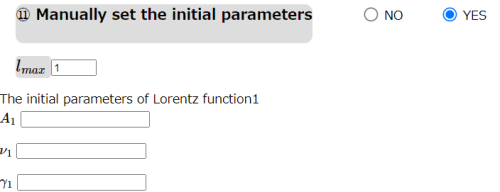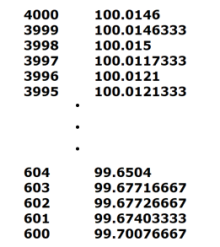「入力」の版間の差分
ナビゲーションに移動
検索に移動
| 2行目: | 2行目: | ||
: [[File:Newtoppage.png|1000px]] | : [[File:Newtoppage.png|1000px]] | ||
: | : これはComplexRIの標準入力のスナップショットである。 | ||
: | : ComplexRIの入力は大きく二つに分類される。一つは、ATR-IR実験の情報に関する部分、もう一つは複素屈折率のフィッティングのパラメータを調整する部分である。以下で、それぞれについて説明する。 | ||
---- | ---- | ||
| 10行目: | 10行目: | ||
---- | ---- | ||
<div id="Input01" style="font-size: 150%;"> ①ATR-IR File </div> | <div id="Input01" style="font-size: 150%;"> ①ATR-IR File </div> | ||
: | : ここでは、ATR-IRの実験データをアップロードしてほしい。中身は以下のようになっている必要がある。 | ||
: [[File:NewFILE01.png|200px]] | : [[File:NewFILE01.png|200px]] | ||
: | : ファイル形式には二つのルールがある。 | ||
: (1). | : (1). テキスト形式である。 | ||
: (2). | : (2). 各列は空白で区切られている。 | ||
---- | ---- | ||
<div id="Input02" style="font-size: 150%;"> ②The order of data </div> | <div id="Input02" style="font-size: 150%;"> ②The order of data </div> | ||
: | : データの並び方を指定してほしい。 | ||
:: Ascending order: | :: Ascending order: 振動数が昇順 (下の図の左側). (デフォルト) | ||
:: Descending order: | :: Descending order: 振動数が降順 (下の図の右側). | ||
:[[File:NewFILE01.png|200px]][[File:NewFILE04.png|220px]] | :[[File:NewFILE01.png|200px]][[File:NewFILE04.png|220px]] | ||
2021年12月24日 (金) 03:07時点における版
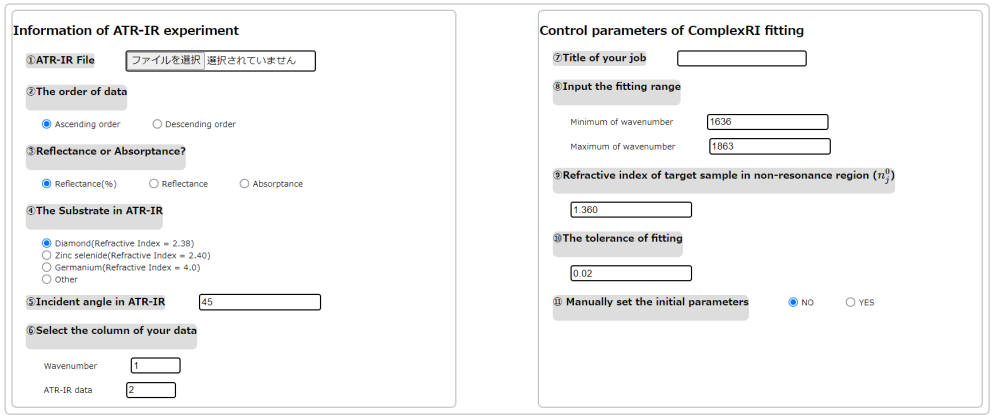
- これはComplexRIの標準入力のスナップショットである。
- ComplexRIの入力は大きく二つに分類される。一つは、ATR-IR実験の情報に関する部分、もう一つは複素屈折率のフィッティングのパラメータを調整する部分である。以下で、それぞれについて説明する。
Information of ATR-IR experiment
①ATR-IR File
- ここでは、ATR-IRの実験データをアップロードしてほしい。中身は以下のようになっている必要がある。
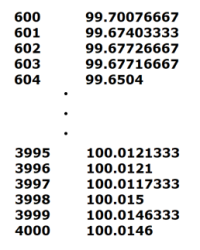
- ファイル形式には二つのルールがある。
- (1). テキスト形式である。
- (2). 各列は空白で区切られている。
②The order of data
③Reflectance or Absorptance?
- Please select the type of your ATR-IR data.
- Reflectance(%): The Reflectance of ATR-IR spectra in the value of percentage. (Default)
- Reflectance: The Reflectance of ATR-IR spectra.
- Absorptance: The Absorptance of ATR-IR spectra.
- The relationships between each data are
④The Substrate in ATR-IR
- Please select the substrate you used in the ATR-IR experiment. Here, we prepare the three substrates often used
- Diamond(Refractive Index = 2.38)
- Zinc selenide(Refractive Index = 2.40)
- Germanium(Refractive Index = 4.0).
- You can also input the refractive index of your substrate by selecting Others in the list.

⑤Incident angle in ATR-IR
- Please input the incident angle in your ATR-IR experiment. (Default=45 degree)
⑥Select the column of your data
- Please input the column number of the data you want to analyze in your ATR-IR file.
- Wavenumber: The column number of wavenumber in your input file. (Default: 1)
- ATR-IR data: The column number of ATR-IR data in your input file. (Default: 2)
- For example, an input file like following can be uploaded and column 1 and column 5 can be selected for analyzing.
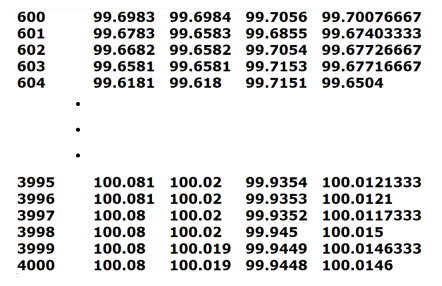
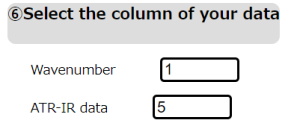
Control parameters of ComplexRI fitting
⑦Title of your job
- Please input the title of your job (alphabet). The output results of ComplexRI will be saved in the excel format with the name @Title.xlsx
⑧Input the fitting range
- Please input the frequency range (in wavenumber) you want to perform the fitting. ComplexRI will fit the data only inside the range you input here.
- Minimum wavenumber: The lower boundary of wavenumber. (Default: 1636)
- Maximum wavenumber: The upper boundary of wavenumber. (Default: 1863)
⑨Refractive index of target sample in non-resonance region ()
- Please input the refractive index of the target sample () in non-resonance region. (Default=1.360)
- should be determined before the fitting procedure (see Equation in ⑪). In the reference paper, we use the refractive index values in the visible regions to fit Cauchy's equation.
- The obtained parameters were used to evaluate the refractive index at 5000 wavenumber.
⑩The tolerance of fitting
- Please input the tolerance of fitting procedure. The fitting will be finished when the calculated residual is less than this value.
- The details are written in the explanation01 of Internal processing.
- Notice!! Fitting can not finish if this value is too small.
⑪ Manually set the initial parameters
- Please select whether to set the initial fitting parameters by yourself.
- No: Automatically done by the algorithm (Default)
- Yes: Manually set the initial parameters by users.
- In the fitting, we use a set of Lorentz functions to represent the complex refractive index
- where is input in ⑨. The number of Lorentz functions , and the corresponding parameters should be determined.
- By selecting , it means the initial parameters are automatically guessed by the algorithm explained in the explanation01 of Internal processing .
- By selecting , you can manually set and for each Lorentz function by yourself. The units of are all wavenumber. is up to 5.
